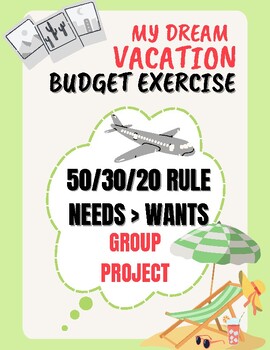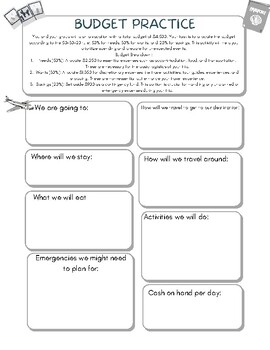Vacation Ventures
- PDF
Description
Project Objective:
To equip high school students with practical financial literacy skills by engaging them in a realistic and interactive group project that involves planning and budgeting for a vacation. This activity aims to foster critical thinking, collaboration, and real-world application of budgeting principles.
Project Description:
Title: Practical Budgeting: Plan a Group Vacation
Overview:
In this dynamic classroom project, students will work in groups to plan a vacation with a fixed budget of $4,500. Using the 50-30-20 rule for budget allocation—50% for needs, 30% for wants, and 20% for savings—each group will navigate real-world financial decisions involving travel, accommodation, food, entertainment, and emergency preparedness.
Learning Objectives:
Financial Planning: Students will learn to allocate resources effectively, distinguishing between essential needs and optional wants.
Critical Thinking: Groups will analyze various spending options and make decisions based on their budget constraints.
Real-World Application: Students will research actual costs of transportation, accommodation, food, and activities to create a realistic travel budget.
Emergency Preparedness: Students will allocate funds for unexpected expenses, learning the importance of emergency savings.
Collaboration: By working in teams, students will enhance their communication and cooperative problem-solving skills.
Activities Include:
Budget Creation: Each group creates a detailed budget plan that addresses all aspects of the trip, adhering to the 50-30-20 rule.
Research Phase: Students research actual prices for flights, hotels, meals, and activities to ensure their plan is realistic.
Adjustments and Justifications: Groups adjust their plans based on research findings and justify their decisions in a presentation to the class.
Contingency Planning: Students discuss and document how they would handle potential emergencies with their allocated savings.
Benefits for Teachers and Students:
Teachers can customize the project to match the duration and depth appropriate for their curriculum.
Provides a hands-on learning experience that prepares students for real-life financial responsibilities.
Encourages teamwork and enhances students’ research and presentation skills.
Intended Outcomes:
Students will complete the project with a deeper understanding of how to manage money wisely and plan ahead for both expected costs and unexpected challenges. This project not only teaches financial basics but also equips students with skills that are critical for independent living.




